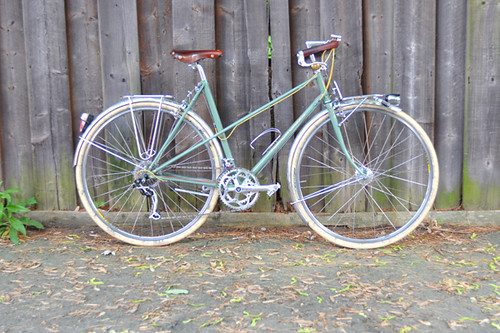There were some animals here and beautiful gardens. We rode a tram and got to hear about the different plants and trees there. It was very interesting!












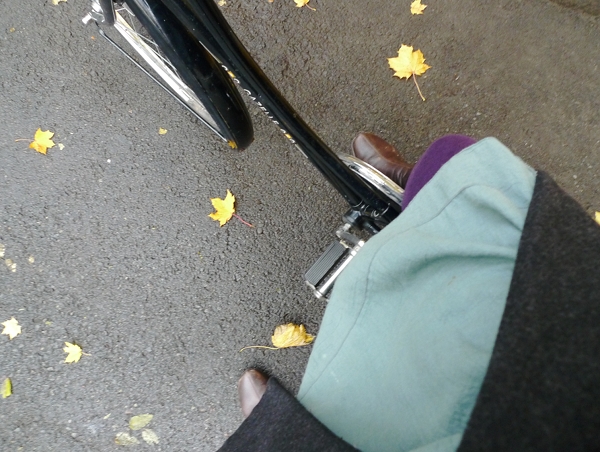 I tend to think of myself as having begun cycling when I got into it as an adult. But technically, that is not so. I learned to ride a bike when I was a child, and rode one all through junior high and most of high school. There was a nice post today on ecovelo, where Alan mentioned having "lived on his bike" as a kid, and in a sense it was similar for me. My friends and I did not race each other through wheatfields or pop wheelies, but we did use our bikes to get around our small town. Even once old enough to drive, most of us somehow still stuck with bicycles: It just seemed easier and even kept us off our parents' radar (for example, they could not look at the odometer to determine whether we had gone out when we were told not to).
I tend to think of myself as having begun cycling when I got into it as an adult. But technically, that is not so. I learned to ride a bike when I was a child, and rode one all through junior high and most of high school. There was a nice post today on ecovelo, where Alan mentioned having "lived on his bike" as a kid, and in a sense it was similar for me. My friends and I did not race each other through wheatfields or pop wheelies, but we did use our bikes to get around our small town. Even once old enough to drive, most of us somehow still stuck with bicycles: It just seemed easier and even kept us off our parents' radar (for example, they could not look at the odometer to determine whether we had gone out when we were told not to). But during all those years of riding bikes as a child and teenager, I knew absolutely nothing about "technique." At some point I was given a 2-wheel bike, and I used it as a push-bike for a few laps around the park until suddenly I was able to pedal without the bike falling over. To me, that meant that I was pretty much done learning "technique." In the years that followed, I rode with the saddle low, never learned how to start and stop "properly" or to pedal while standing, and was not aware that turning involved leaning and balancing, rather than using the handlebars. Heck, I never even learned how to shift gears, because the shifters on my low-end bike were jammed!
But during all those years of riding bikes as a child and teenager, I knew absolutely nothing about "technique." At some point I was given a 2-wheel bike, and I used it as a push-bike for a few laps around the park until suddenly I was able to pedal without the bike falling over. To me, that meant that I was pretty much done learning "technique." In the years that followed, I rode with the saddle low, never learned how to start and stop "properly" or to pedal while standing, and was not aware that turning involved leaning and balancing, rather than using the handlebars. Heck, I never even learned how to shift gears, because the shifters on my low-end bike were jammed!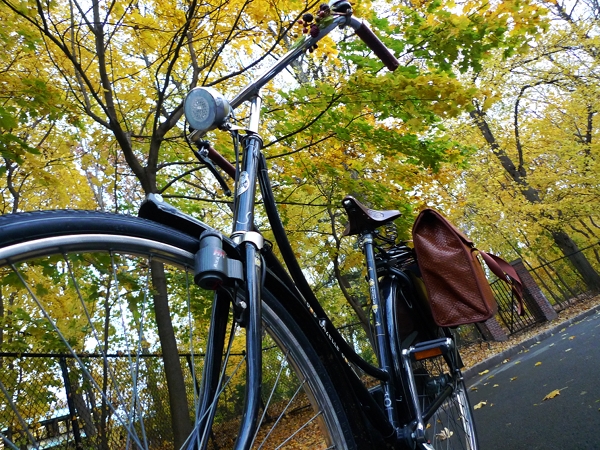 When I think about how it feels to cycle today - and particularly, how it felt when I first started doing it as an adult - I am confused and frustrated by all those younger years spent riding a bike without knowing how to do it properly. It's odd that I did not naturally pick up any skills what so ever during that time. (How can that be? Surely no one is that unathletic?) Moreover, my friends must have been just as clueless, because no one ever made fun of me or told me I was "doing it wrong." And it's frustrating that those skills were so much easier to learn as a child than as an adult - so by not having learned them early, I am at a disadvantage that may take me some effort to overcome.
When I think about how it feels to cycle today - and particularly, how it felt when I first started doing it as an adult - I am confused and frustrated by all those younger years spent riding a bike without knowing how to do it properly. It's odd that I did not naturally pick up any skills what so ever during that time. (How can that be? Surely no one is that unathletic?) Moreover, my friends must have been just as clueless, because no one ever made fun of me or told me I was "doing it wrong." And it's frustrating that those skills were so much easier to learn as a child than as an adult - so by not having learned them early, I am at a disadvantage that may take me some effort to overcome.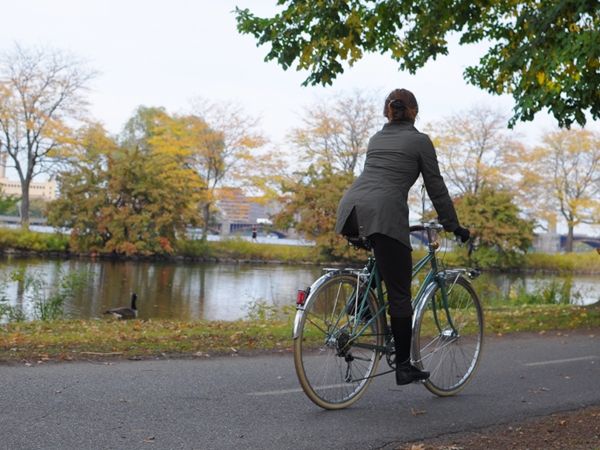 As for saddle height, it is an ongoing fiasco: It took over a year of gradually raising it until I was able to have it at more or less the height where it needs to be for good leg extension... But I still cannot mount a bicycle properly and have to do a graceless little lean-and-hoist maneuver to get myself onto that raised saddle. Terrified of falling, I am highly resistant to being taught, and watching videos of others doing it over and over has not helped. At least I am now finally able to pedal while standing: After months of riding fixed gear, I finally got it (at first I could do it only on the fixed gear, then the skill gradually transferred onto freewheel bikes). I have to say, that was not easy for me to "get". In my head I understood what to do, but my body refused to balance.
As for saddle height, it is an ongoing fiasco: It took over a year of gradually raising it until I was able to have it at more or less the height where it needs to be for good leg extension... But I still cannot mount a bicycle properly and have to do a graceless little lean-and-hoist maneuver to get myself onto that raised saddle. Terrified of falling, I am highly resistant to being taught, and watching videos of others doing it over and over has not helped. At least I am now finally able to pedal while standing: After months of riding fixed gear, I finally got it (at first I could do it only on the fixed gear, then the skill gradually transferred onto freewheel bikes). I have to say, that was not easy for me to "get". In my head I understood what to do, but my body refused to balance. What does it mean, when we say that a bicycle manufacturer has a long history? There are manufacturers out there, whose names are legendary and whose origins date back more than a century. Bianchi was founded in 1885, Raleigh in 1887 and Gazelle in 1892. All three brands still exist today, and the company literature stresses their historical roots. After all, history means legacy, tradition, substance and trust - setting these brands apart from newcomers. But is it really accurate to connect the bikes currently produced under these brand names to their vintage predecessors? After all, Bianchi is now owned by Cycleurope, Gazelle by the Glide Buy Out Fund, and Raleigh by Derby International - venture capital conglomerates that own or manage a variety of brands. Not only has the ownership changed dramatically, but so have the basic designs, the methods production, the facilities, the country of production, and oftentimes the quality of the product. What is it then, that gives the manufacturer continuity?
What does it mean, when we say that a bicycle manufacturer has a long history? There are manufacturers out there, whose names are legendary and whose origins date back more than a century. Bianchi was founded in 1885, Raleigh in 1887 and Gazelle in 1892. All three brands still exist today, and the company literature stresses their historical roots. After all, history means legacy, tradition, substance and trust - setting these brands apart from newcomers. But is it really accurate to connect the bikes currently produced under these brand names to their vintage predecessors? After all, Bianchi is now owned by Cycleurope, Gazelle by the Glide Buy Out Fund, and Raleigh by Derby International - venture capital conglomerates that own or manage a variety of brands. Not only has the ownership changed dramatically, but so have the basic designs, the methods production, the facilities, the country of production, and oftentimes the quality of the product. What is it then, that gives the manufacturer continuity? [image via J. Ferguson]
[image via J. Ferguson]
 This year the actual Solstice is on June 20 at 23:09, however its effects will be noticed for a much longer period of time and are in fact currently being observed. Since the 20th is a weekday you can actually make it to the Fremont Fair and the associated parties going on this weekend, get down, recover and STILL get out in the wilderness or wherever else you enjoy being for the actual day of Solstice. (Just assuming wilderness is your thing since this is a blog about climbing Mount Rainier.)
This year the actual Solstice is on June 20 at 23:09, however its effects will be noticed for a much longer period of time and are in fact currently being observed. Since the 20th is a weekday you can actually make it to the Fremont Fair and the associated parties going on this weekend, get down, recover and STILL get out in the wilderness or wherever else you enjoy being for the actual day of Solstice. (Just assuming wilderness is your thing since this is a blog about climbing Mount Rainier.)









 The OYB Pannier is a small Swiss army surplus bag, modified via the addition of rack attachments and other features byJeff Potter - the owner and author of the project Out Your Backdoor ("indie outdoor lore and more"). I purchased this bag asa smaller alternative to the enormous shopper pannier I normally use. My criteria were durability, classic aesthetics, a trustworthy attachment system, a reasonable price, and a size just large enough to snugly fit my medium format camera equipment or my (very small) laptop.While I am aware that these same bags (without the bike-ready modifications) can be purchased from several other sources, I opted for the OYB version because I wanted the modifications to be made by someone with experience and because I wanted to support the "Out Your Backdoor" project, which provides some great resources for its readers.
The OYB Pannier is a small Swiss army surplus bag, modified via the addition of rack attachments and other features byJeff Potter - the owner and author of the project Out Your Backdoor ("indie outdoor lore and more"). I purchased this bag asa smaller alternative to the enormous shopper pannier I normally use. My criteria were durability, classic aesthetics, a trustworthy attachment system, a reasonable price, and a size just large enough to snugly fit my medium format camera equipment or my (very small) laptop.While I am aware that these same bags (without the bike-ready modifications) can be purchased from several other sources, I opted for the OYB version because I wanted the modifications to be made by someone with experience and because I wanted to support the "Out Your Backdoor" project, which provides some great resources for its readers. Compact and boxy, the pannier is a Swiss military bag made of a thick, stiff, olive-green waxed canvas with brown leather trim and steel rivets. The OYB leather patch is a lighter shade than the rest of the leather on the bag, but this can easily be changed with a modest application of neatsfoot oil or even Proofide.I am not sure whether this particular bag started out as new-old-stock, or whether it had been used in its previous life, but to me it looks more like the former. The condition is better than I had expected based on the pictures and product description on OYB.
Compact and boxy, the pannier is a Swiss military bag made of a thick, stiff, olive-green waxed canvas with brown leather trim and steel rivets. The OYB leather patch is a lighter shade than the rest of the leather on the bag, but this can easily be changed with a modest application of neatsfoot oil or even Proofide.I am not sure whether this particular bag started out as new-old-stock, or whether it had been used in its previous life, but to me it looks more like the former. The condition is better than I had expected based on the pictures and product description on OYB.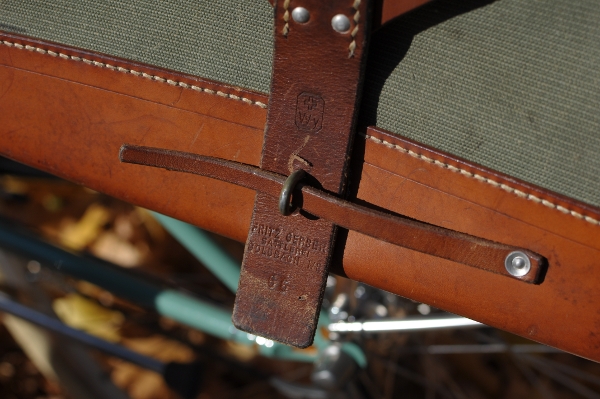 The closure system is simple and secure: That very stiff leather cord pulls out of the metal loop, and the thick leather strap lifts up off the loop to open the bag. For those curious, the imprint on the leather reads "Fritz Gerber Sattlerei, Goldbach."
The closure system is simple and secure: That very stiff leather cord pulls out of the metal loop, and the thick leather strap lifts up off the loop to open the bag. For those curious, the imprint on the leather reads "Fritz Gerber Sattlerei, Goldbach." The attachment system is a combination of metal hooks and bungee cords, with which the pannier is secured to the rear rack.The rack I have on this bicycle is theConstructeurrack fromVelo Orange, which is quite small.
The attachment system is a combination of metal hooks and bungee cords, with which the pannier is secured to the rear rack.The rack I have on this bicycle is theConstructeurrack fromVelo Orange, which is quite small.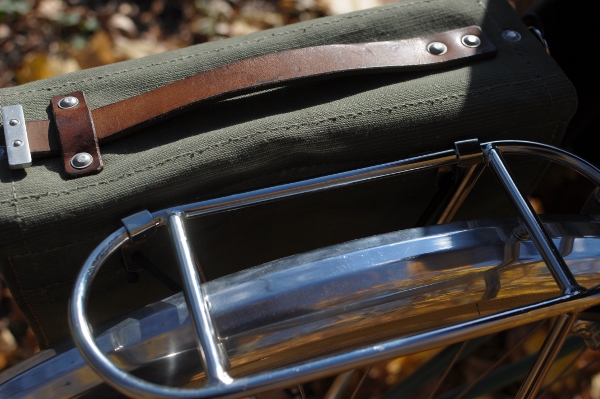 Here is a close-up of the metal hooks. They are riveted on to the bag.
Here is a close-up of the metal hooks. They are riveted on to the bag.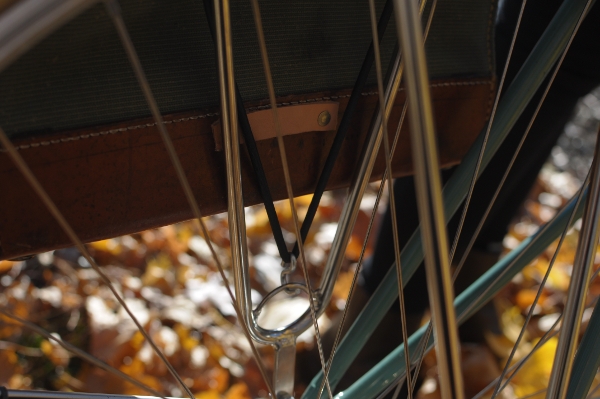 And here is a close-up of the bungee attachment. Together, these two attachment points ensure that the pannier does not sway or bounce against the rack - a good feature when you are planning to carry camera equipment. When the bag is not being used as a pannier, the bungee hook attaches to that small leather strip you see on the back of the bag - so that it does not hang loose. [Edited to add: I am now told that the bungee cord is supposed to go through that leather loop before you hook it to the bottom of the rack - oops.]
And here is a close-up of the bungee attachment. Together, these two attachment points ensure that the pannier does not sway or bounce against the rack - a good feature when you are planning to carry camera equipment. When the bag is not being used as a pannier, the bungee hook attaches to that small leather strip you see on the back of the bag - so that it does not hang loose. [Edited to add: I am now told that the bungee cord is supposed to go through that leather loop before you hook it to the bottom of the rack - oops.] In addition to the rack attachments, the OYB pannier can be ordered with a number of other optional features, including shoulder strap attachments with a removable shoulder strap. I asked for the strap, because I pan to carry the bag around when off the bike, and this set-up essentially this gives me a camera bag and pannier in one. Other options include lights mounts, and a variety of other attachments.
In addition to the rack attachments, the OYB pannier can be ordered with a number of other optional features, including shoulder strap attachments with a removable shoulder strap. I asked for the strap, because I pan to carry the bag around when off the bike, and this set-up essentially this gives me a camera bag and pannier in one. Other options include lights mounts, and a variety of other attachments. To give you a sense of scale, here is the pannier in relation to me and to the entire bike. It is a small bag. Dimensions are listed as:8.5" tall, 4" deep, 11.25" wide (5.4 liters). Inside, the length of the bag is listed at 10.75", but I was hoping against hope that it would fit my laptop. OYB gives instructions for stretching the bag out with magazines in order to make it fititems of that size, and I will give this a try.If I can get my laptop to fit, I will be thrilled - but I am not getting my hopes upand am prepared to content myself with this being a camera bag only.
To give you a sense of scale, here is the pannier in relation to me and to the entire bike. It is a small bag. Dimensions are listed as:8.5" tall, 4" deep, 11.25" wide (5.4 liters). Inside, the length of the bag is listed at 10.75", but I was hoping against hope that it would fit my laptop. OYB gives instructions for stretching the bag out with magazines in order to make it fititems of that size, and I will give this a try.If I can get my laptop to fit, I will be thrilled - but I am not getting my hopes upand am prepared to content myself with this being a camera bag only. If it were not for the laptop fit issue, this would pretty much be my dream pannier. The mil-spec colour scheme is not for everyone, but I love it, and it suits almost all of my bikes nicely. The durability of military surplus items is superb, and I appreciated getting the bag customised by Jeff atOYB. This is a classic, versatile, and reliable little pannier refashioned by someone who loves bicycles.
If it were not for the laptop fit issue, this would pretty much be my dream pannier. The mil-spec colour scheme is not for everyone, but I love it, and it suits almost all of my bikes nicely. The durability of military surplus items is superb, and I appreciated getting the bag customised by Jeff atOYB. This is a classic, versatile, and reliable little pannier refashioned by someone who loves bicycles. It is here, at Narada Falls, that the sparkling clear waters of Paradise River plunge over the edge of a cliff and drop dramatically 168 feet. The Paradise River runs clear, not milky, because it originates from snowfields, not debris-laden glaciers.
It is here, at Narada Falls, that the sparkling clear waters of Paradise River plunge over the edge of a cliff and drop dramatically 168 feet. The Paradise River runs clear, not milky, because it originates from snowfields, not debris-laden glaciers. For some early visitors, the power of the waterfall suggested spiritual connections. They named it Narada after a powerful sage of Hindu mythology who acted as a messenger between human and divine realms. [National Park Service Sign]
For some early visitors, the power of the waterfall suggested spiritual connections. They named it Narada after a powerful sage of Hindu mythology who acted as a messenger between human and divine realms. [National Park Service Sign] It wasn't the biggest, or tallest, or widest waterfall I've ever seen. But it was one of the most beautiful and graceful.
It wasn't the biggest, or tallest, or widest waterfall I've ever seen. But it was one of the most beautiful and graceful. There is a hint of a rainbow across the center of the falls.
There is a hint of a rainbow across the center of the falls. The “drapery” of water opens and closes as it falls. It was enchanting.
The “drapery” of water opens and closes as it falls. It was enchanting. Constantly changing as you watch, it is dependent upon the flow of water from above as well as the cliff face itself and the plants thriving there.
Constantly changing as you watch, it is dependent upon the flow of water from above as well as the cliff face itself and the plants thriving there.
 Pulling into the parking lot there were low clouds and not much sign of the sun. We walked the thirty seconds to the lower town wall to see much of it wet, including potential starts to routes we were intending to do. I walked around for other objectives while Adam took a party separation. Godzilla was dripping and Princely Ambitions was plenty wet. I met Adam back at the base of Aries crack where I told him we might as well climb since we were already there. We geared up at the base of Aries crack hoping to continue onto Taurus after we gained the first ledge. Or at least we would see if things looked dry enough to continue.
Pulling into the parking lot there were low clouds and not much sign of the sun. We walked the thirty seconds to the lower town wall to see much of it wet, including potential starts to routes we were intending to do. I walked around for other objectives while Adam took a party separation. Godzilla was dripping and Princely Ambitions was plenty wet. I met Adam back at the base of Aries crack where I told him we might as well climb since we were already there. We geared up at the base of Aries crack hoping to continue onto Taurus after we gained the first ledge. Or at least we would see if things looked dry enough to continue. Heading into the Aries crux
Heading into the Aries crux Adam on GNS
Adam on GNS

